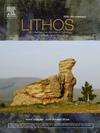Origin, petrogenesis and tectonic implications of the Jiasha potassic intrusive complex in the giant Gejiu SnCu polymetallic field, SW China
IF 2.9
2区 地球科学
Q2 GEOCHEMISTRY & GEOPHYSICS
引用次数: 0
Abstract
The potassic intrusive complex is a series of mafic to felsic rock assemblages with high potassium content and is characterized by large amounts of K-feldspar, plagioclase, biotite and, hornblende. The Jiasha potassic intrusive complex (JPIC) comprises monzogabbro, porphyritic monzonite, quartz monzonite, and monzogranite. The zircon U![]() Pb dating shows that the ages of monzogranite are 86.5–87.0 Ma. The ages of monzogabbro, porphyritic monzonite, and quartz monzonite are 85.7–86.9 Ma, 79.1–83.3 Ma, and 77.2–78.0 Ma. The JPIC belongs to metaluminous to weak peraluminous and show affinities of shoshonite. The JPIC have high (87Sr/86Sr)i values (0.7097–0.7118) and a wide range of εNd(t) values (−5.03 to −8.24). The zircon 176Hf/177Hf isotopic ratios are homogeneous (0.2825–0.2827), εHf(t) values vary from −2.1 to −7.1. The ratios of Pb isotope are: (206Pb/204Pb)i = 18.1180–18.5021, (207Pb/204Pb)i = 15.6180–15.7681, (208Pb/204Pb)i = 38.7160–39.3672. The whole-rock geochemical, zircon Hf and whole-rock Sr-Nd-Pb isotopic characteristics, together with mineral composition collectively suggest that the JPIC resulted from fractional crystallization and varying degrees of crustal contamination of enriched lithospheric mantle. The depletion of Nb, Ta and Ti in JPIC is inherited from the source region, which may be caused by the infiltration of slab-derived fluid or melt into the mantle when the Paleo-Pacific subducted to the South China. The late Cretaceous magmatism and mineralization activities in Gejiu is the product of the subduction of the Palaeo-Pacific Plate beneath the Eurasian continent, which probably formed under an Andean-type active continental margin setting.
Pb dating shows that the ages of monzogranite are 86.5–87.0 Ma. The ages of monzogabbro, porphyritic monzonite, and quartz monzonite are 85.7–86.9 Ma, 79.1–83.3 Ma, and 77.2–78.0 Ma. The JPIC belongs to metaluminous to weak peraluminous and show affinities of shoshonite. The JPIC have high (87Sr/86Sr)i values (0.7097–0.7118) and a wide range of εNd(t) values (−5.03 to −8.24). The zircon 176Hf/177Hf isotopic ratios are homogeneous (0.2825–0.2827), εHf(t) values vary from −2.1 to −7.1. The ratios of Pb isotope are: (206Pb/204Pb)i = 18.1180–18.5021, (207Pb/204Pb)i = 15.6180–15.7681, (208Pb/204Pb)i = 38.7160–39.3672. The whole-rock geochemical, zircon Hf and whole-rock Sr-Nd-Pb isotopic characteristics, together with mineral composition collectively suggest that the JPIC resulted from fractional crystallization and varying degrees of crustal contamination of enriched lithospheric mantle. The depletion of Nb, Ta and Ti in JPIC is inherited from the source region, which may be caused by the infiltration of slab-derived fluid or melt into the mantle when the Paleo-Pacific subducted to the South China. The late Cretaceous magmatism and mineralization activities in Gejiu is the product of the subduction of the Palaeo-Pacific Plate beneath the Eurasian continent, which probably formed under an Andean-type active continental margin setting.
个旧铜多金属田嘉沙钾质侵入杂岩成因及构造意义
钾质侵入杂岩是一系列含钾量高的基性-长英质岩石组合,以大量钾长石、斜长石、黑云母和角闪石为特征。嘉沙钾质侵入杂岩体由二长辉长岩、斑状二长岩、石英二长岩和二长花岗岩组成。锆石UPb测年结果表明,二长花岗岩年龄为86.5 ~ 87.0 Ma。二长辉长岩、斑状二长岩和石英二长岩的年龄分别为85.7 ~ 86.9 Ma、79.1 ~ 83.3 Ma和77.2 ~ 78.0 Ma。JPIC属铝质至弱过铝质,具有舒顺石的亲缘关系。JPIC具有高的(87Sr/86Sr)i值(0.7097 ~ 0.7118)和宽的εNd(t)值(- 5.03 ~ - 8.24)。锆石176Hf/177Hf同位素比值均匀(0.2825 ~ 0.2827),εHf(t)值在−2.1 ~−7.1之间。Pb同位素比值为:(206Pb/204Pb)i = 18.1180 ~ 18.5021, (207Pb/204Pb)i = 15.6180 ~ 15.7681, (208Pb/204Pb)i = 38.7160 ~ 39.3672。全岩地球化学特征、锆石Hf和全岩Sr-Nd-Pb同位素特征以及矿物组成共同表明,JPIC是由富集岩石圈地幔的分离结晶和不同程度的地壳污染所致。JPIC中Nb、Ta、Ti的耗损是源区遗传的,可能是古太平洋向华南俯冲时,板块衍生流体或熔融物渗入地幔所致。个旧地区晚白垩世岩浆作用和成矿作用是古太平洋板块向欧亚大陆俯冲的产物,可能形成于安第斯型活动大陆边缘环境下。
本文章由计算机程序翻译,如有差异,请以英文原文为准。
求助全文
约1分钟内获得全文
求助全文
来源期刊

Lithos
地学-地球化学与地球物理
CiteScore
6.80
自引率
11.40%
发文量
286
审稿时长
3.5 months
期刊介绍:
Lithos publishes original research papers on the petrology, geochemistry and petrogenesis of igneous and metamorphic rocks. Papers on mineralogy/mineral physics related to petrology and petrogenetic problems are also welcomed.
 求助内容:
求助内容: 应助结果提醒方式:
应助结果提醒方式:


